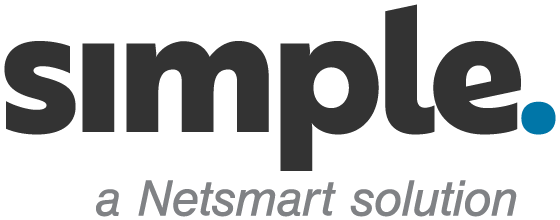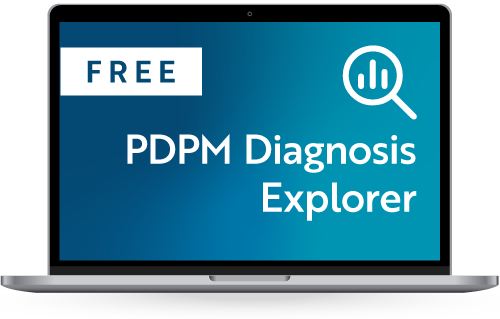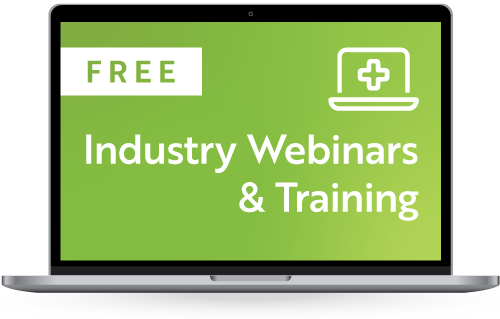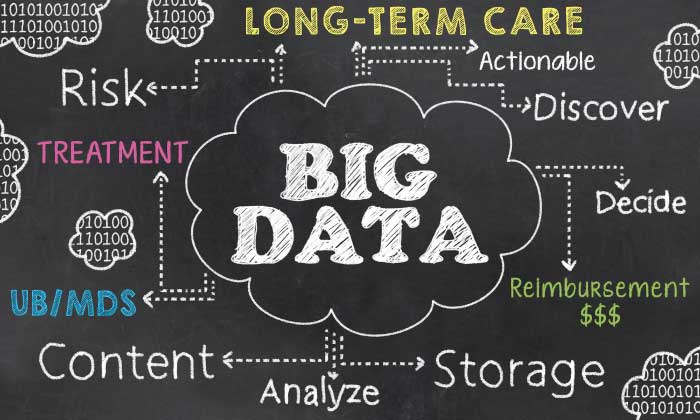It turns out to be an exciting time for advancements in healthcare, thanks to Big Data. That’s great for medical research and for all of us as individual patients, but what about our industry? Can long-term care providers reap benefits from data they are already collecting?
A recent article by Dr. Francis Collins of the National Institutes of Health clearly illustrates how data holds the promise of directly improving the health of individuals. In this example, a Stanford University researcher sifted through mountains of existing data to look for new links among genes, diseases and traits.
One promising discovery was that patients with elevated magnesium levels were much more likely to be diagnosed with gastric cancer than patients with normal magnesium levels. Another surprising connection was found between lung cancer and prostate specific antigen (PSA), a known risk marker for prostate cancer.
Data is a boon for patient care and research
Not only might these types of discoveries lead to new predictive or diagnostic tests, the study findings suggest a potential new model of medical study. Dr. Collins asserts that the data we already have might hold the answers to important medical questions. We just have to figure out the right ways to interpret it.
“Besides being handy for patients and doctors, data may provide priceless raw material for the next era of biomedical research.” says Dr. Collins. “Indeed, we are at a point in history where big data should not intimidate, but inspire us.”
But what about long-term care?
While big data has huge potential to affect healthcare research and delivery, the LTC industry faces unique challenges. A recent industry article highlights the risk of “data overload” in our industry, brought on by too much information and not enough tools or processes with which to manage it.
Due to the convergence of technological change and regulatory pressure, long-term care providers face unique challenges when it comes to data.
While technology is advancing rapidly, and volumes of data continue to pile up, providers often lack the proper analytic tools and processes – not to mention the time – to properly understand and benefit from it.
Making data make sense in long-term care
Though not without challenges, it is possible to find valuable, actionable intelligence within LTC data. In fact, many industry experts, including SimpleLTC Chief Technology Officer Jason Jones, point out that we’ve reached a “perfect storm” for data in our industry.
Data mining is a science unto itself, but that doesn’t mean that the average business can’t reap benefits from data they already own. Here are five ways that can happen for LTC organizations:
1) Place data analysis within your workflow
With the explosion of data has come a corresponding explosion of software tools to mine it. But often these tools
work outside your current business processes. That can mean they are of little to no use if they don’t fit your workflow.
To ensure value, find software that fits logically within your business workflow so that you’re able to extract and analyze data as a natural process, rather than as a separate task.
For example, at SimpleLTC we’ve developed SimpleAnalyzer™, an analytics and business intelligence tool for MDS 3.0 assessments and UB-04 claims, which fits naturally within the MDS analysis and transmission process.
2) Look for actionable data
“Actionable data” is one of those buzzword-y terms that consultants and cloud computing companies like to throw around. But it’s not a complicated concept; it simply means that data without corresponding results is useless.
Imagine a mining company looking for gold. They wouldn’t randomly start digging holes hoping to hit paydirt. They would instead do research to find a location where gold is likely to be found, and would ensure they had the ability to pull it out of the ground and refine it before starting. Otherwise their effort would be wasted.
The same is true of data. To make your data actionable, be sure that what you’re analyzing fits closely with the business goals of the organization and that it can directly influence decisions that will improve outcomes.
Here are some categories that SimpleLTC customers are tracking to improve both financial and clinical outcomes:
- How do our facility’s quality measures compare to our industry as a whole?
- Which RUG levels are “on the bubble,” or marginally close to a higher or lower reimbursement rate?
- Which individual quality measures are most important for improving resident care?
- Which therapy rules most directly affect change of therapy (COT) and end of therapy (EOT) determinations?
3) Focus on “One Metric That Matters”
Big data is exactly that: BIG. Which, as noted above, can quickly create “data overload” for any organization without clear insights and processes for dealing with it.
Rather than attacking that mountain of data with a shovel and hoping to unearth nuggets of brilliant insight, a better approach is to focus on the One Metric That Matters (OMTM), a concept outlined in the popular business book Lean Analytics.
Finding your OMTM means focusing on a single key metric that can make the most impact on your business at this particular time. That metric might change over time, but sticking to one metric at a time means that you are setting realistic, short-term data goals that will make an immediate difference in outcomes.
In our industry, the OMTM for a skilled nursing company might be related to financial goals (RUG “bubbles” that can change reimbursement rates) or therapeutic outcomes (change of therapy or start of therapy conditions). But focusing on too many goals at one time can dilute results for all of them.
4) Make data available to the appropriate individuals – then empower them
While data analysis might sound like an arcane pursuit, or something best reserved for data scientists, it can actually be a straightforward process that generates quick results. But that can only happen if the appropriate people have access to the data and the power to act on it.
For example, SimpleLTC customers are automating UB-04 analysis to improve billing processes and staff workflow. By sharing the data with key teams, they are able to make business decisions more quickly and improve financial outcomes.
One example is the often-painful UB triple-check process. Customers report that replacing their outdated manual UB analysis review with automated analytics has not only eliminated human errors, it has improved workflow.
And because the information is automated and shared with key individuals, there is an instant time savings as well. In some cases, triple-check meetings have been cut down from full-day endeavors to two-hour meetings.
5) Leverage collective intelligence
Collective intelligence is what emerges when a group shares knowledge and works together to create a better outcome for all. A simple example is that of online shopping. When you visit Amazon.com, you can see reviews and feedback from thousands of other consumers, which helps you make better buying decisions.
Collective intelligence is also something that can improve our industry, and new technology is allowing that to happen. By allowing experts to collaborate and share knowledge, data analysis tools can improve reimbursement and resident care for all the organizations that participate.
SimpleLTC customers, for example, are leveraging this concept within SimpleAnalyzer to combine the expertise of clinical, business office and reimbursement experts nationwide. Analysis rules that are created by one user can be shared in a central library, then adopted and modified by other users to fit their needs.
This sharing of collective intelligence creates an ever-growing resource for continual improvement of UB and MDS analytics.
Data holds plenty of potential for long-term care
The conclusion? Even though healthcare data may be in an awkward adolescent phase, there’s still plenty of potential for LTC organizations. And regardless of what you think of it now, eventually it will change your job.
While some are ignoring the concept of big data and many are scratching their heads, smart companies are learning ways to leverage the data they already have for quick, beneficial results.
By employing one or more of the methods outlined here, they’ve been able to create simple yet actionable models that automate analytics processes, reduce manual error, and improve clinical and financial outcomes.






2 Comments on “5 ways to leverage analytics in long-term care”
Hello,
I’m currently a doctoral student at Capella University looking to talk about the practices BI consultants use to integrate predictive analytics in skilled nursing facilities. If this topic might be of interest to your organization please send me a message and I can discuss with you the details of what I am looking for.
Thank you,
Hi Jacqueline, thank you for reaching out. I’ll pass along your message and contact information to our CTO. Thanks so much!